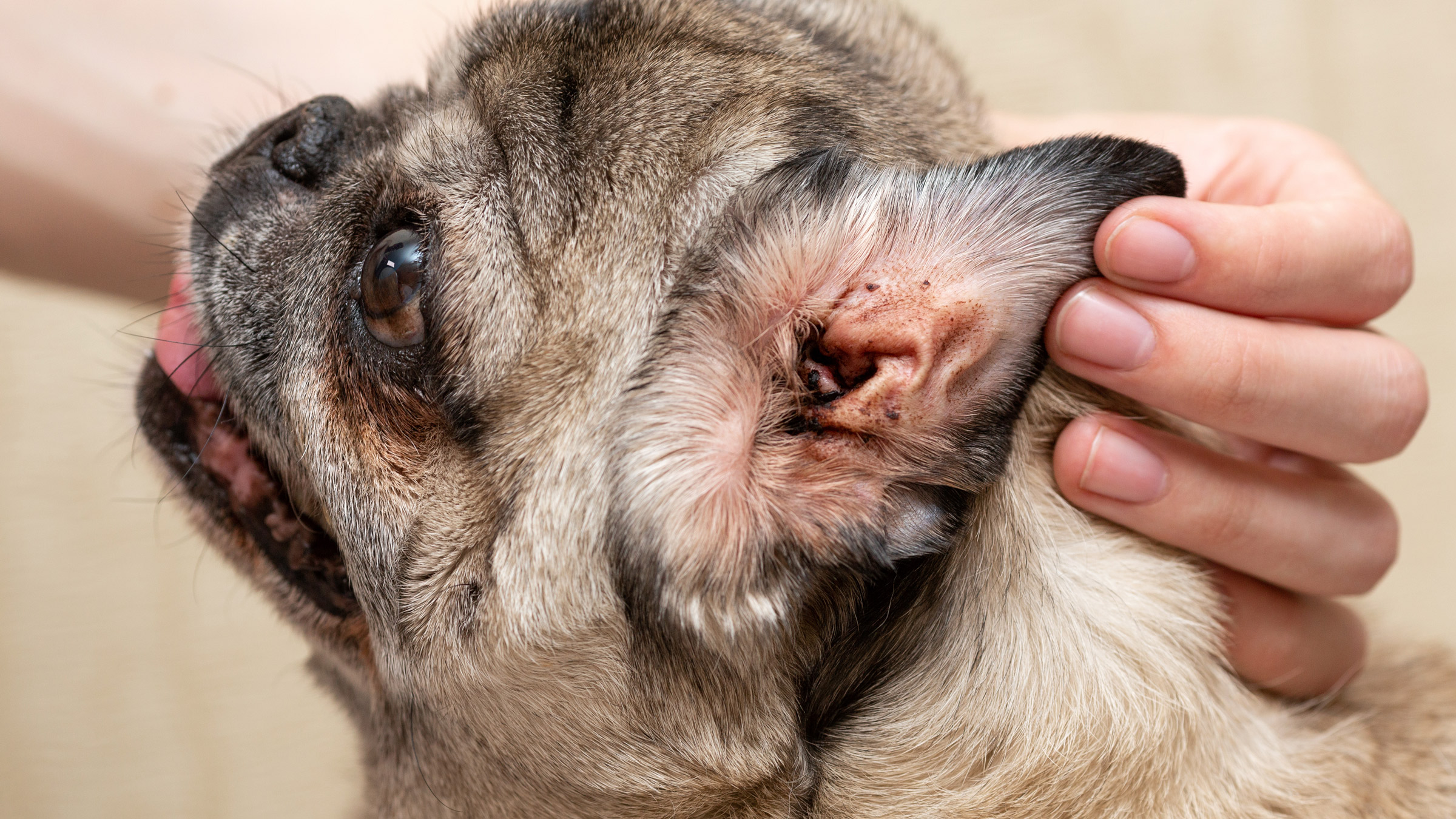If your dog has mites, you may notice hair loss, dandruff, excessive scratching, and visible irritation such as red skin. You may even be able to see the mites on their skin if you part the fur and look closely.
Mites are tiny spider-like creatures that can typically only be seen with a microscope, but sometimes they may be visible as tiny orange, black, or white dots moving on your dog’s skin. It is important to address mite infestations promptly to relieve discomfort and prevent further complications for your dog.
Regular grooming and routine veterinary care can help detect and treat mite infestations early.

Credit: bayshore-vet.com
Signs Of Mite Infestation In Dogs
A mite infestation in dogs can cause discomfort and irritation for our furry friends. It’s important to recognize the signs of mite infestation early on to seek proper treatment and provide relief to your dog. Here are some common signs to look out for:
Visible Signs On The Skin
If you notice any visible signs on your dog’s skin, such as redness, inflammation, or small bumps, it could be a sign of mite infestation. These mites are small, spider-like creatures that are often difficult to see with the naked eye. However, if you carefully part your dog’s fur and look closely, you may be able to spot them. If you do see any signs of mites on your dog’s skin, it’s crucial to consult with a veterinarian for proper diagnosis and treatment.
Excessive Scratching And Irritation
One of the most common signs of mite infestation in dogs is excessive scratching. Mites cause intense itching and discomfort for dogs, leading them to scratch or bite the affected areas incessantly. If you notice that your dog is scratching more than usual, especially in specific areas like the ears, face, or paws, it could indicate a mite infestation. Additionally, you may observe your dog rubbing his body against furniture or the floor to relieve the itching sensation caused by mites.
Hair Loss And Dandruff
Mites can also cause hair loss and dandruff in dogs. If you notice patches of hair loss or thinning fur on your dog’s body, it may be due to mite infestation. Additionally, mites can lead to the appearance of dandruff-like flakes on your dog’s skin. These flakes may be dry and white, causing further discomfort for your pet. If you observe any hair loss or dandruff on your dog, it’s essential to consult with a veterinarian to determine if mites are the underlying cause.

Credit: aectulsa.com
Different Types Of Mites In Dogs
Dog mite symptoms can include hair loss, dandruff, excessive scratching, and visible irritation such as red skin. Mites, tiny spider-like creatures, may be visible as tiny orange, black, or white dots moving on your dog’s skin. If you suspect your dog has mites, it’s best to consult a veterinarian for proper diagnosis and treatment.
Sarcoptic Mange
One of the different types of mites that can affect dogs is sarcoptic mange, also known as canine scabies. This type of mite infestation is caused by Sarcoptes scabiei, a microscopic parasite that burrows into the skin of the dog. Sarcoptic mange is highly contagious and can be transmitted to other dogs or even humans through direct contact with an infected animal. Symptoms of sarcoptic mange include intense itching, hair loss in patches, red or inflamed skin, and sores or scabs. Dogs with sarcoptic mange may scratch or bite at themselves excessively, often leading to secondary skin infections. If you notice these symptoms in your dog, it is important to seek veterinary treatment immediately to prevent the spread of the infection and alleviate your dog’s discomfort.Demodectic Mange
Another type of mite that can affect dogs is demodectic mange, also known as demodicosis or red mange. Demodex canis, a type of mite that naturally lives in small numbers in the hair follicles and oil glands of healthy dogs, can multiply and cause an infestation under certain conditions. Puppies with weaker immune systems or dogs with compromised immune systems are more susceptible to demodectic mange. Symptoms of demodectic mange include hair loss, often in circular patches, especially around the eyes, mouth, and feet. The skin in these areas may become red, inflamed, or scaly. Demodectic mange is not usually itchy, but secondary bacterial infections can cause itching and discomfort. If you suspect your dog has demodectic mange, it is important to consult with your veterinarian for an accurate diagnosis and appropriate treatment.Ear Mites
Ear mites are another common type of mite infestation in dogs, particularly in puppies and dogs with long ears. These mites, known as Otodectes cynotis, live in the ears of dogs and can cause significant irritation and discomfort. Ear mites feed on ear wax and tissue debris, and their presence can lead to inflammation, excessive ear scratching, head shaking, and a strong odor coming from the ears. If your dog has ear mites, you may notice a dark, crumbly discharge in their ears, as well as redness and swelling. Ear mite infestations can also spread to other pets in the household if proper treatment is not administered. It is important to have your dog’s ears checked regularly and seek treatment from a veterinarian if you suspect an ear mite infestation. In conclusion, it is crucial to be aware of the different types of mites that can affect dogs. Sarcoptic mange, demodectic mange, and ear mites are common mite infestations in dogs and can cause various symptoms and discomfort for your furry friend. If you notice any signs of mite infestation in your dog, seek veterinary care to properly diagnose and treat the issue.Diagnosing And Treating Mites In Dogs
Skin Scrapings and Microscopic ExaminationOne of the most common methods used to diagnose mites in dogs is through skin scrapings and microscopic examination. During this process, a veterinarian will use a blade or scraping tool to collect a sample of the dog’s skin. The sample is then examined under a microscope to identify any mites or their eggs. This allows for an accurate diagnosis and helps determine the specific type of mite infestation.
Medicated Shampoos and DipsOnce mites have been diagnosed, treatment can begin with medicated shampoos and dips. These products are specially formulated to kill mites and alleviate the symptoms associated with mite infestations. The dog is thoroughly bathed using the medicated shampoo or dip, ensuring that the entire body is covered. This helps to eliminate mites on the surface of the skin and provide relief from itching and irritation.
Prescription Medications and AntibioticsIn more severe cases of mite infestations, prescription medications and antibiotics may be necessary. Prescription medications are often used to directly kill the mites and prevent them from reproducing. Antibiotics may be prescribed if secondary bacterial infections are present due to the mite infestation. These medications help to eliminate both the mites and the accompanying infections, promoting faster healing and recovery.
It is important to note that regular follow-up appointments and skin scrapings are usually recommended to monitor the progress of treatment and ensure that the mite infestation is fully eradicated. This allows the veterinarian to adjust treatment plans if necessary and prevent any recurrences.
Treating mites in dogs requires a comprehensive approach that targets the mites, relieves symptoms, and prevents further complications. With the right diagnosis and appropriate treatment, your furry companion can experience relief from mite infestations and regain their overall health and comfort.

Credit: www.goodrx.com
Frequently Asked Questions On How Do You Know If Your Dog Has Mites
How Do You Get Rid Of Mites On A Dog?
To get rid of mites on a dog, you can use medicated shampoos, dips, and prescription medications. If there are secondary bacterial infections, antibiotics may also be prescribed. Regular skin scrapings are done to monitor the mite count. Symptoms of mites include hair loss, dandruff, excessive scratching, and visible irritation.
Mites appear as tiny orange, black, or white dots moving on the dog’s skin. Humans can catch dog mites, but the mites cannot complete their life cycle on human skin.
How Can You Tell If A Dog Has Mites?
If your dog has mites, you may notice hair loss, dandruff, excessive scratching, and red skin. You may even see mites on their skin if you look closely.
What Do Skin Mites Look Like On Dog?
Skin mites on dogs appear as tiny orange, black, or white dots moving on their skin. They are microscopic creatures, usually only visible with a microscope.
Can A Human Get Mites From A Dog?
Yes, humans can get mites from dogs, but the mites cannot complete their life cycle on human skin. This can cause some skin irritation in humans, but it is not a long-lasting issue.
Conclusion
To conclude, identifying whether or not your dog has mites is essential for their well-being. Look out for symptoms such as hair loss, dandruff, excessive scratching, and visible irritation. By parting their fur and closely inspecting their skin, you might even spot the mites themselves.
If you suspect mites, it’s important to consult a veterinarian for proper diagnosis and treatment. Remember, early detection can prevent further complications and ensure your furry friend stays healthy and happy.



